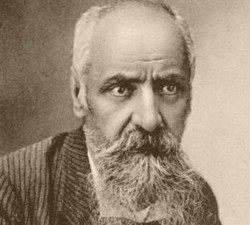Alfredo Oriani was born in Faenza in 1852 and died in Casola Valsenio in 1909.
He began his studies at Bologna, continuing in Rome and graduating in Jurisprudence at the University of Naples in 1872. He returned to Bologna to practise law but understood right away that his ideal life was of quite another nature: in fact he loved solitude, meditation and the humanities.
He gave up the legal profession and moved to the family villa in Casola Valsenio: this is where Oriani the man of letters came into being, novelist and essayist but also historian, journalist and playwright.
In 1876 Alfredo Oriani published the autobiographical work Memorie inutili [Useless Memories] from which his personality emerges, troubled, sometimes reckless but fundamentally romantic: the same romanticism that pervades his deep patriotism.
A series of publications ensued: in 1877 Al di là [Beyond], a story of love between two women; in 1879 the short stories of Gramigne[Couch Grasses] and in 1881 No, followed by the four novellas Quartetto in 1883. These resulted in his being labelled an “obscene” writer.
In 1886 Oriani shifted his field of interest with the essay Matrimonio [Marriage] in which he speaks out against divorce, a political issue at the time. His historical essays Fino a Dogali [Until Dogali] and La lotta politica in Italia [The Political Struggle in Italy] date to 1889 and 1892 respectively.
The writer then returned to fiction with the novels Il nemico [The Enemy] and Gelosia [Jealousy], both of 1894, La disfatta [The Defeat] in 1896, Vortice [Vortex] in 1899 and Olocausto [Holocaust] in 1902, the same year he published La bicicletta[The Bicycle] and his play L’invincibile [The Invincible].
He concluded his writing career in 1908 with the powerful historical-philosophical work La rivolta ideale [The Ideal Revolt].
Alfredo Oriani died on 18th October 1909 in Casola Valsenio, at the age of only 56.
Additional Notes:
In Casola Valsenio you can visit the House-Museum “Il Cardello” where Alfredo Oriani spent much of his life and wrote all his works. The Cardello is first mentioned in a document dated 1419. It changed hands often before it was bought in 1855 by Luigi Oriani, Alfredo’s father. The Oriani family moved there definitively in 1866 and owned it until 1978 when Luigia Pifferi Oriani, widow of Alfredo’s only child Ugo, left it in her will to the “Casa di Oriani” Foundation, together with the surrounding land.



